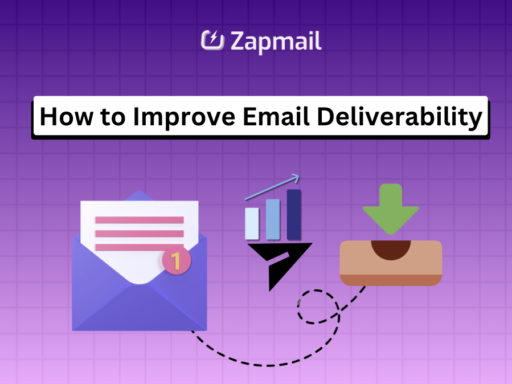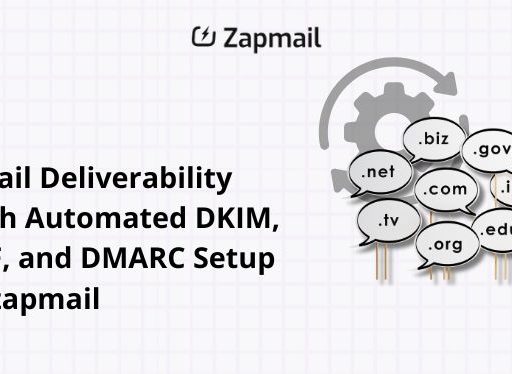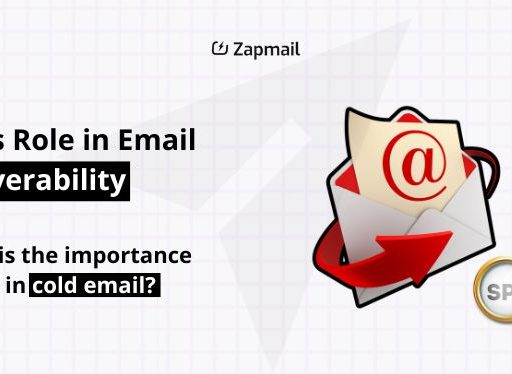Email deliverability is key for any email campaign success. It means your emails get to the right people’s inboxes. In 2024, knowing about email deliverability and how to boost it is vital. Spam filters, strict email checks, and your sender reputation make it tough to get emails delivered.

Studies show only 79.6% of emails made it to their destination in 2022. That’s about one in five emails not reaching their inbox. Bad email deliverability hurts your engagement, conversions, and brand image. Cold emailer need to know what affects deliverability and how to improve their email setup.
This guide will cover email deliverability basics, the difference between delivery and deliverability, and the importance of sender reputation. We’ll also talk about email authentication, making your content better, and keeping an eye on deliverability metrics. By learning these and using smart strategies, you can make your email campaigns better and get your messages to the right people.
Key Takeaways
- Email deliverability is the ability of your emails to reach recipients’ inboxes successfully.
- Sender reputation, spam filters, and email authentication protocols significantly impact deliverability rates.
- Maintaining a good sender reputation score (above 80 on a scale of 100) is crucial for optimal deliverability.
- Implementing SPF, DKIM, and DMARC email authentication helps protect against email spoofing and improves deliverability.
- Regularly monitoring deliverability metrics and adhering to best practices set by inbox providers is essential for success.
Understanding the Basics of Email Deliverability
Email deliverability is key to a successful cold email campaign. It means an email lands in the inbox, not the spam folder. Cold emailers focus on content and design to boost engagement. But getting into the inbox is just as important.
Many things can affect email deliverability. The sender’s reputation, email content, and sending volume are big factors. A low sender score can make ISPs see you as spam. Emails with too many spam words or bad content also get flagged.
To improve email deliverability, focus on a strong sender reputation. Use email authentication like SPF and DKIM. Also, keep an eye on important metrics. By understanding deliverability and using best practices, businesses can reach more inboxes and meet their outreach goals.
Email Delivery vs Email Deliverability: What’s the Difference?
Understanding the difference between email delivery and deliverability is key for successful cold email campaign. These terms are often mixed up, but they mean different things in the email sending process. Let’s look at what each term means and how they differ.
What is Email Delivery?
Email delivery is when an email is sent from the sender’s server to the recipient’s server. It shows how many emails were not bounced back. A high delivery rate means most emails were accepted by the recipient’s server, no matter where they end up.
What is Email Deliverability
Email deliverability is more specific. It’s about getting an email into the recipient’s inbox, not just their server. It’s about inbox placement, or how many emails actually reach the inbox.
key differences between email delivery and deliverability:
- Scope: Delivery checks if an email reaches the server. Deliverability checks if it lands in the inbox.
- Factors affecting performance: Delivery problems often come from technical issues. Deliverability depends on sender reputation, content quality, and more.
- Metrics and measurement: Delivery rates are usually higher because they don’t consider inbox placement. Deliverability needs more advanced tools to track.
Cold emailers can improve these differences. They should monitor key metrics, keep their email list clean, and follow best practices. Testing and refining strategies is also important for better reach and engagement.
Factors That affecting Email Deliverability Rates
Many important factors affect how well your emails get delivered. Knowing these and using best practices can help your emails reach their destination. This ensures your messages get to the right people’s inboxes.
Sender Reputation and Its Impact on Deliverability
Sender reputation is key to email success. Internet Service Providers (ISPs) give a score based on your sending history. A good score means your emails are more likely to land in the inbox.
Things that affect your reputation include:
- Bounce rates
- Spam complaints
- How engaged people are with your emails
- The quality of your email list
- How often you send emails
To keep a good reputation, watch your scores closely. Clean your email list often and send content that matters. Also, handle bounces and complaints quickly.
The Role of Email Authentication Protocols (SPF, DKIM, DMARC)
Email authentication protocols like SPF, DKIM, and DMARC are crucial. They help ISPs trust your emails and stop spam. Using these protocols well can boost your email delivery rates.
Content Optimization for Better Deliverability
Your email’s content also matters for delivery. Some things in your emails might set off spam filters. This could send your messages to spam or block them. To avoid this, consider the following:
- Don’t use words like “free,” “guarantee,” or “credit card”
- Keep a good balance of images and text
- Use fewer capital letters, symbols, and punctuation
- Make sure your emails are useful and interesting to your subscribers
- Personalize your emails to get more engagement
By making your emails better and avoiding spam triggers, you can get more of them into inboxes. This helps you connect with your audience better.
Best Practices for Improving Email Deliverability
Getting your emails to the right inbox is key. By using best practices and managing your email list well, you can boost your delivery success. Personalizing your emails for each person is a great start. It makes your emails more engaging and less likely to be marked as spam.
Using a double opt-in for new subscribers is also important. It makes sure only people who really want to hear from you are on your list. This helps avoid spam complaints and keeps your sender reputation strong. Testing your emails regularly is another must. It helps you find and fix problems before sending to more people.
Following data protection laws like GDPR is a must. Getting clear consent from your subscribers and making it easy for them to unsubscribe keeps your list clean. A smaller, more engaged list is better than a big one with lots of complaints.
How to improve email deliverability?
- Regularly clean your email list by removing inactive or invalid addresses
Regularly remove addresses that don’t engage with your emails. This helps keep your list healthy and improves deliverability.
- Maintain a consistent sending schedule to establish a positive sender reputation:
Send emails consistently to build trust with email providers. A steady pattern helps ensure your emails reach the inbox.
- Avoid using spam trigger words in your subject lines and content:
Steer clear of words that may flag your email as spam. Use clear and simple language to keep your emails from being filtered out.
- Encourage your subscribers to add your email address to their contact list:
Ask your subscribers to save your email address. This increases the chances of your emails landing in their inbox.
- Monitor your email metrics closely and adjust your strategy as needed:
Keep an eye on how your emails perform. Use data to make changes that can boost engagement and improve deliverability.
Focus on managing your list, personalizing emails, using double opt-in, testing, and following GDPR. These steps will greatly improve your email delivery rates. Building a good sender reputation takes time, but the benefits – like more engagement and sales – are worth it.
What Is Email Deliverability and Why It Matters for Effective Outreach
Email deliverability is crucial for an effective cold emailing strategy. It ensures that your emails reach the right person’s inbox, rather than being filtered out or marked as spam. High deliverability increases the chances of engagement and response from potential leads. If your cold emails fail to deliver effectively, it can severely impact your outreach success and overall return on investment (ROI).
The Importance of Reaching the Inbox
Getting your emails into the inbox is the main goal. When they do, you’re more likely to grab the recipient’s attention and get them to take action. Sadly, about a quarter of emails never make it, and almost half are seen as junk. So, making sure your emails get delivered is very important.
Open rates also depend on deliverability. Emails stuck in spam or blocked don’t get opened. But, emails that make it to the inbox have a better chance of being read. Campaigns that are more targeted have a 14.31% higher open rate, showing the value of both deliverability and personalization.
Consequences of Poor Deliverability on Email Campaigns
Poor deliverability can hurt your email campaigns a lot. Emails stuck in spam or blocked can harm your reputation with email service providers. These providers use algorithms to check if you’re trustworthy. If you’re not, they might block your future emails.
In bad cases, you might get blacklisted. This makes it hard to reach your audience and takes a lot of time to fix. It also lowers engagement and click-through rates, hurting your ROI.
To avoid these problems, focus on improving your email deliverability. Use best practices like keeping your email list clean and using email authentication. Also, optimize your email content and watch your deliverability metrics. This way, you can boost your chances of getting your emails into the inbox and making your cold email campaign more effective.
Measuring and Monitoring Email Deliverability Metrics
Keeping your email campaigns successful is all about good deliverability. By watching key metrics, you can spot problems early and fix them. This keeps your sender reputation strong. Let’s look at the important metrics and tools to track your deliverability.
Key Metrics to Track for Deliverability
Watch these metrics closely to check your email deliverability:
- Bounce Rate: Try to keep your bounce rate under 5%. High bounce rates can mean bad email list quality or server issues.
- Open Rate: Open rates are less reliable now, but they still show how engaged your audience is. Aim for an average of 24%.
- Click-Through Rate: This shows how many people clicked on your email links. A high rate means your content is hitting the mark.
- Complaint Rate: Aim for a complaint rate under 0.1%. Too many complaints can hurt your reputation and deliverability.
- Unsubscribe Rate: Watch how many people unsubscribe. A high rate might mean your content or sending frequency isn’t right.
Tools and Techniques for Monitoring Deliverability Performance
To keep an eye on your deliverability, use these tools and methods:
- Deliverability Tools: Use tools that check your sender reputation and spam rates. They help you find and fix deliverability problems.
- Inbox Placement Testing: Test where your emails land in different providers’ inboxes. This shows if they’re being filtered or lost.
- Authentication Monitoring: Make sure your SPF, DKIM, and DMARC records are set up right. Good email authentication builds trust and boosts deliverability.
- Engagement Tracking: Track open and click-through rates to see how well your emails are doing. High rates help your reputation and deliverability.
- Subscriber List Maintenance: Clean and update your list regularly. Remove bad addresses to keep your reputation and lower complaint rates.
By watching these metrics and using the right tools, you can keep your email deliverability strong. Remember, a good sender reputation takes work and attention every day.
Conclusion
In this guide, we’ve covered the basics of getting your emails to the right people. Understanding the difference between delivery and deliverability helps you focus on what really matters. Keeping a good sender reputation, using authentication, and making your emails engaging are key to success.
Following best practices is essential for the best results. This means keeping your email lists clean, having a low bounce rate, and avoiding spam. Also, watch your open rates, click-through rates, and unsubscribe rates to improve your campaigns.
FAQ
Email deliverability shows how well your emails get to your subscribers’ inboxes. It looks at things like who you are as a sender, what you write, and how you prove you’re who you say you are. It also checks how your readers interact with your emails.
Email delivery is when your email gets to the server of the person you’re sending it to. But, deliverability is about whether it actually lands in their inbox. Even if it’s delivered, it could still go to spam, which affects how well you’re doing.
Several things affect how well your emails get delivered. These include your reputation as a sender, the reputation of your IP address, and how you prove you’re who you say you are. Also, how you write your emails and how your readers interact with them matter a lot. Keeping a good reputation and following best practices can help a lot.
To get your emails delivered better, follow some key steps. Keep your email list clean and use double opt-in. Make your emails personal and avoid words that might get flagged as spam. Also, make sure your subject lines are catchy and easy to unsubscribe from your emails. Test your emails before sending them out and make sure you follow GDPR rules.
To keep an eye on how well your emails are doing, track a few important metrics. Look at bounce rates, open rates, and how often your emails land in inboxes. Also, check click-through rates, complaint rates, your domain’s reputation, and how well your email authentication works. Regularly checking these can help you spot and fix any problems.
There are many tools out there to help you improve your email deliverability. You can find inbox placement tools, tools to check for blacklists, spam content analysis tools, and platforms for testing your emails. These tools can help you find and fix issues to make your emails more likely to get delivered.



